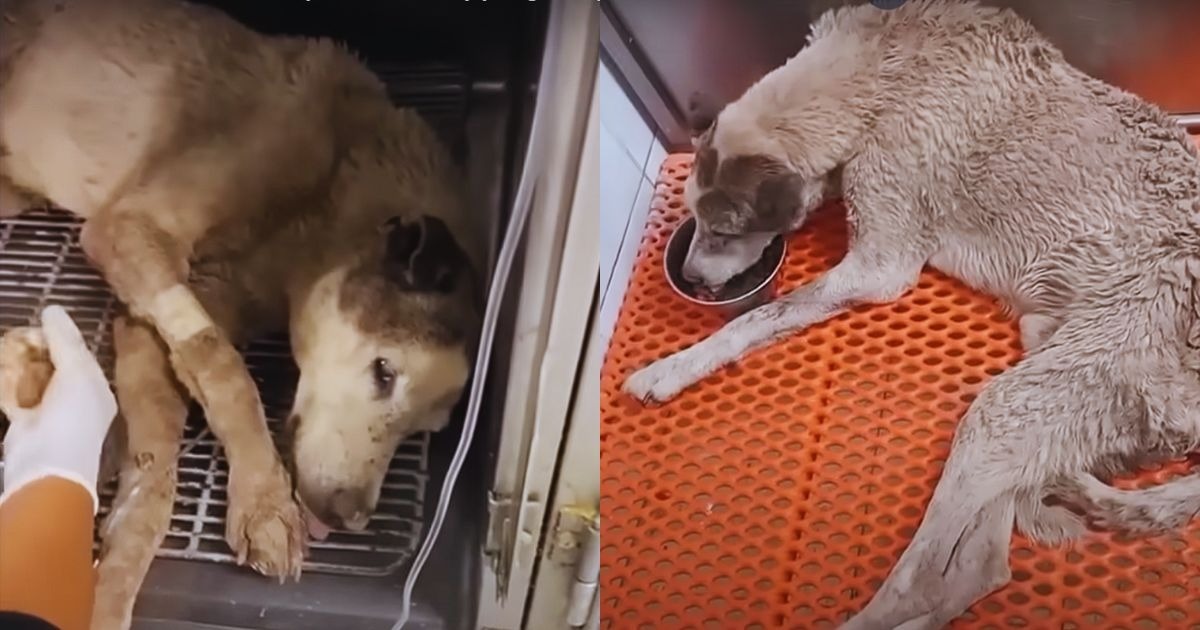The sun was sinking behind the hills when the river grew quiet again. Only the faint lapping of water against mud broke the stillness. Near the bank lay a dog—mud-soaked, trembling, waiting for footsteps that would never return.
His name wasn’t known then. No one had called him in days. His fur clung to his bones, matted with grime and river silt, and his ribs rose and fell in slow, shallow breaths. The water had crept close, touching his paws, but he didn’t move. He just stared across the river, eyes searching for someone who wasn’t coming back.
Abandoned by the River
Earlier that day, a car had stopped at the edge of the old bridge. A man stepped out, his movements unsteady, the engine still running. He opened the back door, and a thin brown dog jumped out, wagging his tail. The man said something—a word the dog had learned meant stay—then got back in the car.
The door slammed. Tires spun. The car disappeared down the dirt road, dust rising in the twilight.
The dog stood there for a moment, confused. Then he ran after it. His legs were fast but not fast enough. When the sound of the engine faded, he stopped. The road ended by the river, and the world went quiet again.
He didn’t bark. He just lowered himself to the mud and waited.
Across the water, people saw him. A few children pointed, their mothers calling them back inside. The houses glowed softly as dusk settled, and soon only the dog and the river remained.
Hours passed. His cries were faint, but they carried—thin, desperate notes that cut through the night air like a plea for mercy.
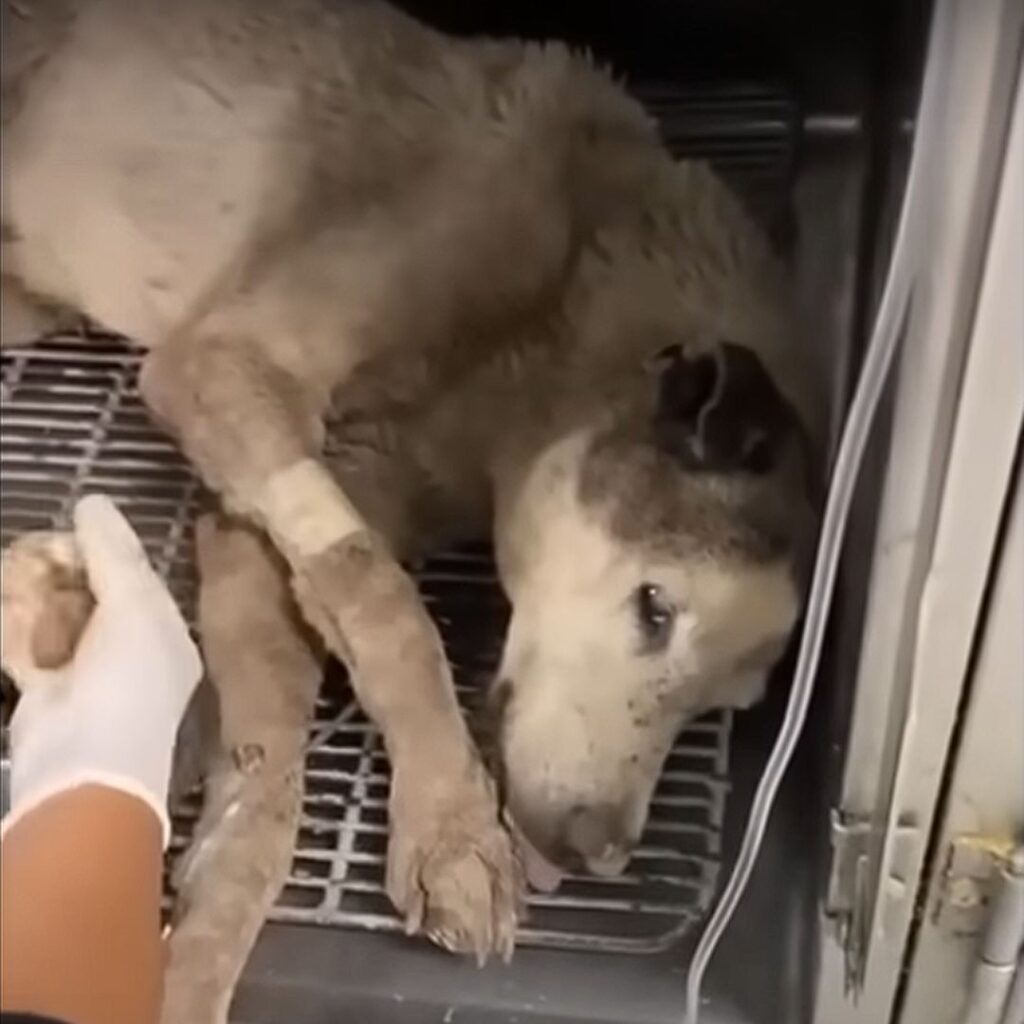
A Hand Reaches Out
By morning, the villagers could no longer ignore the sound. A small group gathered by the river’s edge: two young men, a woman in rubber boots, and an older farmer. They could see him now, lying half-submerged in the mud.
“He’s still alive,” the woman whispered.
The current was shallow but thick with silt. They waded through it, slow and careful, the water rising to their knees. When they reached him, the dog didn’t flinch. He lifted his head weakly, his eyes wide but calm. A low whimper escaped his throat.
“It’s okay, boy,” one man murmured, crouching beside him. “We’ve got you.”
They lifted him together, his weight heavy with water and exhaustion. He didn’t struggle—just let himself be carried. The woman cradled his head against her chest as they crossed back.
At the small animal clinic in town, the smell of antiseptic filled the air. The vet moved quickly. Tubes, needles, fluids—the rhythm of rescue. The dog’s stomach was bloated and hard. When they pressed it gently, dark sludge spilled out. He had eaten soil and grass, desperate to quiet the ache of hunger.
“He’s been poisoned,” the vet said quietly. “Or maybe he drank from the river. Either way, it’s bad.”
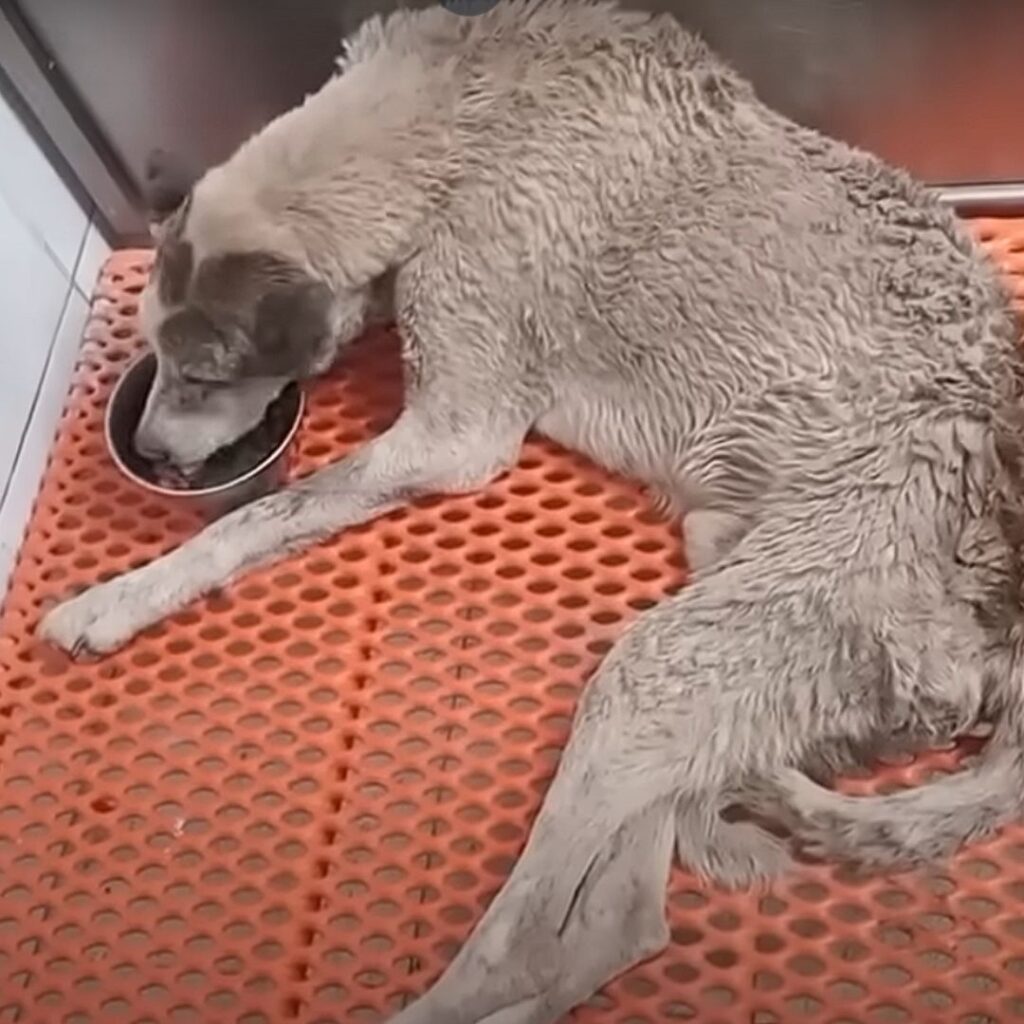
The First Signs of Hope
They flushed his system, injected medicine, and wrapped him in warm towels. The volunteers waited outside, silent except for the occasional sigh. The woman who’d carried him in kept her hands folded, whispering a quiet prayer.
Hours later, the vet stepped out. “He’s stable,” she said. “Weak, but alive.”
When they went in, he was lying on a padded mat, a thin blanket over his body. His eyes opened when they entered. A faint wag of his tail brushed the floor.
The woman smiled through tears. “Hey there, sweetheart,” she said softly. “You made it.”
They named him Camilo, after the river that nearly took him. It suited him—gentle, humble, a survivor.
A Quiet Fight to Live
The next morning, Camilo lifted his head when the vet entered. He still couldn’t stand, but his eyes followed her every move. A small bowl of soft food waited by his bed. The vet knelt and held a spoon to his mouth.
“Come on, buddy,” she coaxed.
He sniffed it once, then licked. Slowly. Cautiously. By the third spoonful, he was eating on his own. It wasn’t much, but it was something. The volunteers who’d rescued him stood nearby, their smiles quiet but bright. They knew what that first meal meant—it meant he’d chosen to fight.
Each day brought small victories. He drank more water. He swallowed pain medication without spitting it out. He let them clean his fur, cutting away the thick mats of mud and filth that clung to his skin.
When they brushed him for the first time, tufts of soft brown fur appeared beneath the grime. His coat, though thin, glowed faintly under the clinic lights. Beneath the dirt and scars, a beautiful dog was emerging.
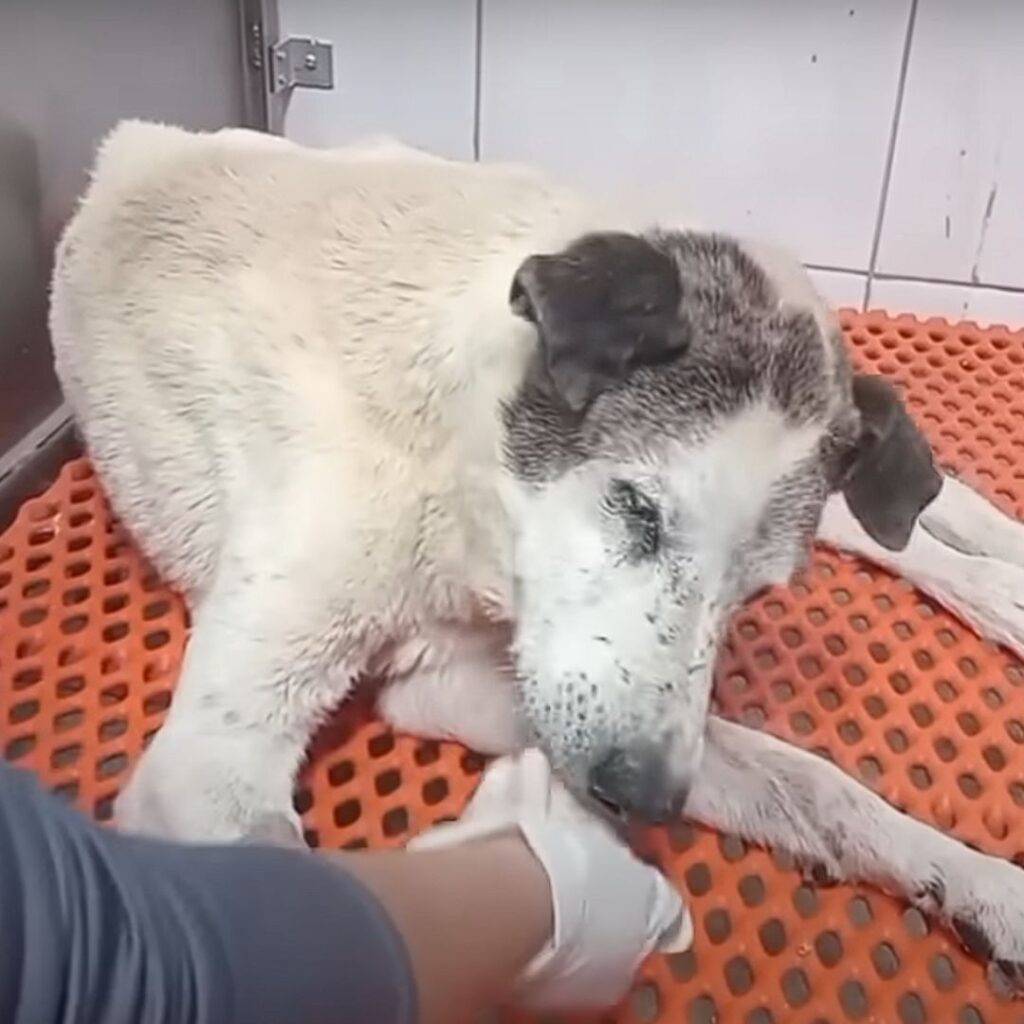
Remembering the Pain
Camilo’s blood tests showed signs of infection, but nothing fatal. His body was weak, yet his heart was steady. Still, he carried fear deep in his bones. When someone walked too fast or raised a hand too high, he flinched. No one knew what he’d endured before that night, but his silence spoke loudly.
Sometimes he’d stare at the window, eyes fixed on the trees beyond. As if remembering. As if hoping the person who left him might come back and see what he’d become.
But the volunteers knew better. Healing doesn’t come from waiting for those who broke you—it comes from learning to trust the ones who stay.
A Name Becomes a Promise
By the third day, Camilo could eat without help. The vet smiled as she wrote on his chart: Appetite improving. Responsive. Gentle temperament.
“He’s a fighter,” she told the volunteers. They nodded, pride softening their faces.
That evening, one of them—a young man named Luis—stayed late. He sat beside Camilo’s crate, reading softly from a worn paperback. Every few minutes, he’d look up, and the dog’s eyes would meet his. There was understanding there, a quiet bond forming between them.
When Luis reached out, Camilo leaned his head into his palm. That simple act—the weight of trust—was enough to undo him. Luis blinked back tears and whispered, “You’re safe now, boy. No one’s leaving you again.”
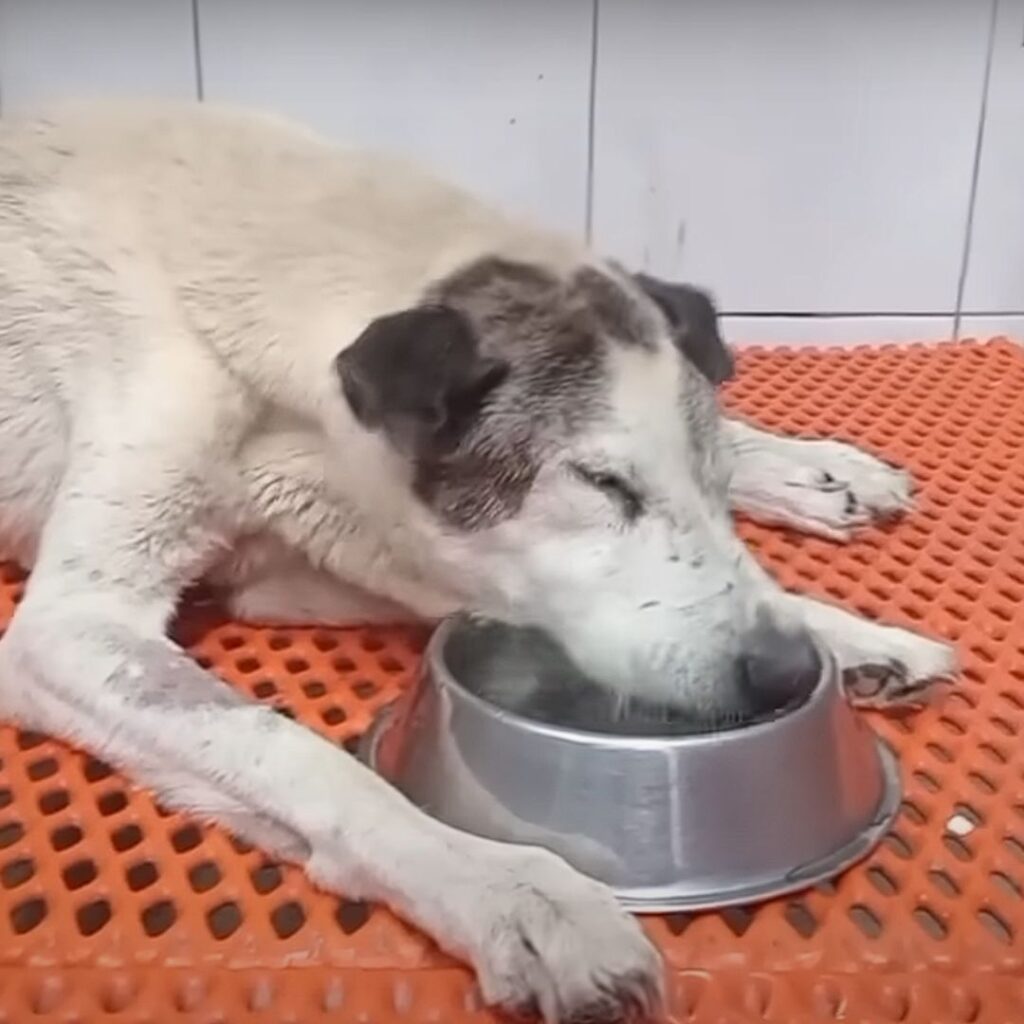
Standing Again
On the fifth day, Camilo surprised everyone. When the vet entered with his breakfast, he pushed himself up on trembling legs. His paws slipped once, twice, but he stayed upright.
The room went silent. Then came applause, laughter, tears. The vet knelt beside him, her hand resting gently on his back. “That’s it,” she said, voice shaking. “That’s our boy.”
From that day, progress came faster. He ate heartily, his tail wagged freely, and his eyes—those soft, brown eyes—began to shine again. He started walking short distances down the clinic hallway, each step unsteady but determined.
They gave him baths, gentle and warm. The water ran brown at first, then clear. When they dried him off, his fur shimmered under the light. For the first time in weeks, he looked like a dog again—not a ghost of one.
From Clinic to Care
After two weeks, Camilo was strong enough to leave intensive care. The rescue organization arranged a foster home nearby—a quiet place with a yard, soft beds, and people who understood patience.
The day he left, everyone at the clinic came to say goodbye. The vet scratched his chin. “You’re ready, buddy,” she said softly. “Go live the life you were meant to have.”
Luis, the volunteer, was there too. He walked him to the car, knelt down, and hugged him. “I’ll come visit,” he promised. Camilo licked his cheek once, a soft thank-you.
At his foster home, the transition was slow. The first night, he didn’t sleep much. He circled his bed, uncertain, before finally curling up and resting his head on the blanket. By morning, he was still there, breathing steady.
Each day, he discovered something new—the feel of grass under his paws, the warmth of the sun, the sound of laughter that didn’t mean danger. He learned what it felt like to be safe.

A New Life Begins
Weeks passed. His muscles filled out, his fur grew thick and glossy. He started running short distances across the yard, tail high, barking softly at butterflies. His limp remained faintly, a scar of survival—but it didn’t slow him down.
When visitors came, Camilo greeted them with cautious curiosity. He no longer flinched when hands reached for him. He’d sniff, then press his head against their palm, asking silently for affection.
His foster family adored him. They shared photos with the rescue group—Camilo napping on a couch, Camilo playing with toys, Camilo rolling in the grass, joy written across his face.
Luis visited often. Each time, Camilo recognized him instantly, tail wagging so hard his whole body shook. The reunion never grew old. Luis would laugh, kneel, and whisper, “See? I told you it gets better.”
The River, Revisited
Months later, they took him back to the river—not the same muddy bank where he’d been found, but farther upstream, where the water ran clean and clear. He stepped in carefully, then splashed, his reflection rippling beneath him.
Luis threw a stick. Camilo chased it, triumphant. The water sparkled around him, sunlight catching his wet fur. When he returned, he dropped the stick at Luis’s feet, tail wagging in pure joy.
No fear. No waiting. Just living.

The Meaning of a Second Chance
Camilo’s story spread through the community, a symbol of compassion and endurance. People who had once turned away from strays began leaving bowls of water outside their homes. Children who had watched from their porches that night now waved when they saw him on walks.
The river had once been a place of loss. Now, it was a place of beginnings.
Camilo will never know why he was left behind. But he doesn’t need to. The people who found him, the hands that carried him, the love that healed him—those are his truths now. His past no longer defines him. His courage does.
He may still glance at the water sometimes, as if remembering. But then he looks forward, his eyes bright, his steps sure.
Because love found him by that river—and it never left.
